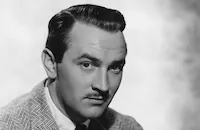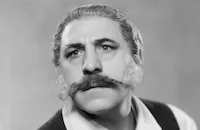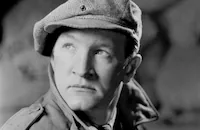The Lady and the Mob

Brief Synopsis
Cast & Crew
Ben Stoloff
Fay Bainter
Ida Lupino
Lee Bowman
Henry Armetta
Warren Hymer
Film Details
Technical Specs

Synopsis
Hattie Leonard, a staid Victorian matron who lives in a grand house on a hill, runs both the local bank and the town. When racketeers move into town and demand protection money from the merchants, Hattie discovers her cleaning costs have dramatically increased because the cleaner, Zambrogio, must pay money to the protection organization. Outraged, Hattie requests that the mayor act to rid the town of the racketeers, and when he refuses, she takes matters into her own hands and imports a gang of trigger men led by Frankie O'Fallon, an ex-thug she once helped. Armed with her bulletproof limousine and a raft of machine guns, Hattie then sets out to clean up the town. Discovering that George Watson is the head of the protection racket, Hattie begins to hijack his collectors and return the money to the merchants. When Watson's gunmen retaliate against the merchants, Lila Thorne, the fiancée of Hattie's son Fred, joins forces with her future mother-in-law and lures Watson to the Leonard house, where Hattie grills him and learns that Mayor Jones is the brains behind the rackets. When Hattie demands the mayor's resignation, he orders her thrown in jail for kidnapping Watson. That night, Hattie's boys saw through the bars on her window so that she can leave her cell. Slipping out on successive nights, Hattie calls on the merchants and gives them the money needed to buy protection. The night that Hattie decides to escape, her boys rouse the district attorney and take him to the Leonard bank. There Hattie opens the mayor's safety deposit box and finds the marked bills she had given to the merchants to pay the racketeers, thus implicating the mayor in the scheme.

Director
Ben Stoloff
Cast

Fay Bainter

Ida Lupino

Lee Bowman

Henry Armetta

Warren Hymer

Harold Huber
Forbes Murray

Joseph Sawyer
Tom Dugan
Joe Caits
Jim Toney
Tommy Mack
Brandon Tynan

George Meeker
Olaf Hytten
Inez Palange
Otto Hoffman
Crew
Lionel Banks
George Bradshaw
George Cooper
Price Day
Kalloch
Fred Kohlmar
Richard Maibaum
Wilbur Mcgaugh
Otto Meyer
Gertrude Purcell
M. W. Stoloff
John Stumar

Film Details
Technical Specs

Articles
The Lady and the Mob
In this mix of gangster flick and comedy, she is not the lady of the title; that distinction belongs to Fay Bainter as Hattie Leonard, a grand old society dame who becomes a female Robin Hood; she starts her own gang to combat the influence of mobsters who are shaking down the town's hard-working merchants. As she begins to uncover dirty doings at the highest levels of town government, Hattie enlists the help of Lila Thorne (Lupino), her son's fiancée.
What sounds like a fairly innocuous story was actually the subject of much wrangling with the Production Code Administration (PCA), the film industry's self-censorship arm. In 1937, when it was still an RKO property, the story was deemed unacceptable because it was "basically a gangster picture, showing machine guns in the hands of criminals." By 1938, it was in pre-production at Columbia, and the studio found its first screenplay draft rejected as well for the same reasons, plus the detailed depiction of a kidnapping and the use of the National Anthem and "My Country 'Tis of Thee." At that time, Edna May Oliver and Wendy Barrie were in line for the female leads. Eventually, script issues were ironed out with the PCA, and Bainter and Lupino were cast.
Bainter was a distinguished stage actress who did not make her film debut until 1934, when she was in her early 40s. Over the next decade, she was featured in a number of important roles, winning a Best Supporting Actress Oscar® for Jezebel (1938) the same year she was nominated for Best Actress for her work in White Banners. Highly sought after for a range of matron roles, her successful film career continued into the early 1950s. She then worked primarily on television for the next ten years, returning to the big screen for The Children's Hour (1961), for which she received another Supporting Actress nomination.
Shortly before making The Lady and the Mob, Ida Lupino married South African-born actor Louis Hayward, who had made a splash earlier in the year as the lead in the swashbuckler The Man in the Iron Mask (1939). The two co-starred in only one movie together, the thriller Ladies in Retirement (1941), and were divorced in 1945.
Director: Benjamin Stoloff
Producer: Fred Kohlmar
Screenplay: Richard Maibaum, Gertrude Purcell
Based on a story by George Bradshaw and Price Day Cinematography: John Stumar
Editing: Otto Meyer
Art Direction: Lionel Banks
Original Music: Charles Bradshaw, Leigh Harline (both uncredited)
Cast: Fay Bainter (Hattie Leonard), Ida Lupino (Lila Thorne), Lee Bowman (Fred Leonard), Henry Armetta (Zambrogio), Warren Hymer (Frankie O'Fallon).
BW-65m.
by Rob Nixon

The Lady and the Mob
Quotes
Trivia
Notes
Working titles for this film were Mrs. Leonard Misbehaves, Old Mrs. Leonard and the Machine Guns and Old Mrs. Leonard and Her Machine Guns. According to an October 1938 Hollywood Reporter news item, Columbia negotiated with Edna May Oliver for the leading part. A later Hollywood Reporter pre-production news item noted that the studio negotiated with Wendy Barrie for the romantic lead. According to information contained in the MPAA/PCA Collection at the AMPAS Library, in 1937, before Columbia became involved in the picturization of Bradshaw and Day's story, RKO submitted it to the PCA for review. The PCA responded that the story was "unacceptable from the point of view of the Production Code" and rejected it because it was "basically a gangster picture, showing machine guns in the hands of criminals." However, the PCA did state that the story "may be corrected by changes clearly showing the activity of the police in cooperation with "Mrs. Leonard." By September 1938, the story was in pre-production at Columbia, which submitted a first draft of the screenplay to the AMPP, only to have it labelled "unacceptable." The PCA informed Columbia that it would have to eliminate four items from the picture in order to have it passed by the administration: the showing of machine guns in the hands of gangsters; the showing of kidnapping for ransom, and details of the abduction; the use of the National Anthem and "My Country 'Tis of Thee"; and the showing of gangsters shooting at law-enforcing officers.














